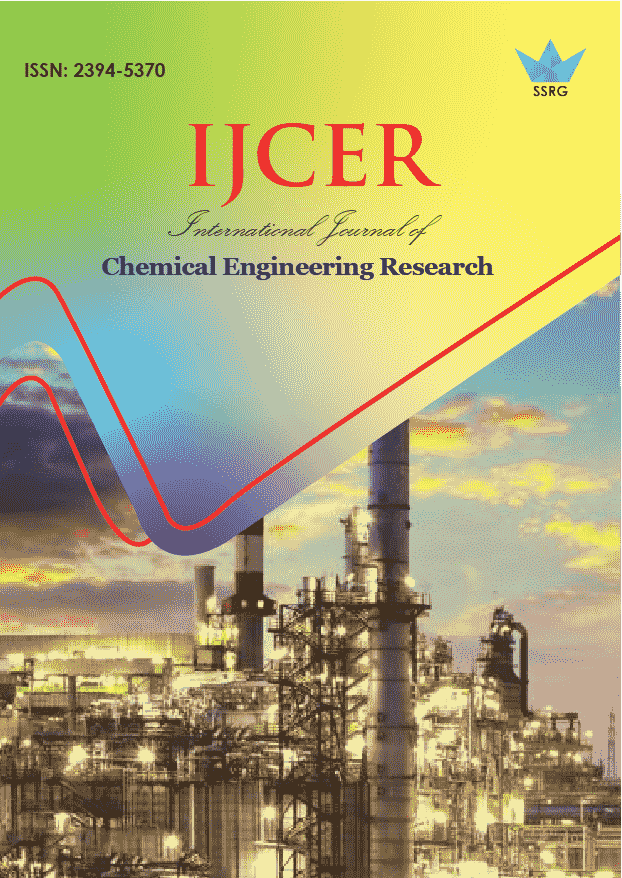Groundnut Shell Adsorbent in Packed Bed for Cadmium Removal- Modeling for Breakthrough Curve

| International Journal of Chemical Engineering Research |
| © 2015 by SSRG - IJCER Journal |
| Volume 2 Issue 2 |
| Year of Publication : 2015 |
| Authors : Sunil J. Kulkarni, Dr. Jayant P. Kaware |
How to Cite?
Sunil J. Kulkarni, Dr. Jayant P. Kaware, "Groundnut Shell Adsorbent in Packed Bed for Cadmium Removal- Modeling for Breakthrough Curve," SSRG International Journal of Chemical Engineering Research, vol. 2, no. 2, pp. 1-6, 2015. Crossref, https://doi.org/10.14445/23945370/IJCER-V2I1P101
Abstract:
Cadmium removal from effluent can be carried out by using various low cost adsorbents prepared from waste materials. The continuous removal of cadmium can be carried out in packed bed. In the current investigation groundnut shell derived adsorbent is used for removal of cadmium from synthetic effluent in a packed bed. The effect of various parameters like initial concentration, flow rate and bed height on the break through curve is studied. It was observed that the exhaustion time decreases with increase in initial concentration and flow rate and it increases with bed height. Experimental data was fitted in three models namely Thomas- BDST, Yoon Nelson and Adam Bohart. Thomas model was most satisfactory for the packed bed cadmium removal by groundnut shell. The values of the model parameters were evaluated and analyzed.
Keywords:
break through curve, model parameters, flow rate and solute uptake
References:
[1] M.Ahamaruzzaman, Role of fly ash in Removal of organic pollutants from wastewater, Energy Fuels, 23 (3), 2009, 1494–1511.
[2] A.Matilainen, M. Vepsalainen, and M. Sillanpaa ,Natural organic matter removal by coagulation during drinking water treatment: A Review, Adv. in Colloid and Interface Sci., 159(2), 2010, 189-197.
[3] Sunil J. Kulkarni, Suhas V Patil, and Y. P. Bhalerao, fly ash adsorption studies for organic matter removal accompanying increase in dissolved oxygen, International Journal of Chemical Engineering and Applications, 2(6),2011,434-438.
[4] Teker M., Mustafa I., adsorption of copper and cadmium ions by activated carbon from rice hulls, Turk J Chem., 23,1999, 185-191.
[5] Olowoyo, D.N and Garuba, A.O, Adsorption of Cadmium Ions using activated carbon prepared from Coconut shell, Global Advanced Research J Food Science and Technology, 1(6),2012, 081-084.
[6] Gupta V. K, Jain CK, Ali I, Sharma M, Saini VK, Removal of cadmium and nickel from wastewater using bagasse fly ash--a sugar industry waste, Water Res.,37,2003, 4038-44.
[7] Visa M., Duţa A, Cadmium and nickel removal from wastewater using modified fly ash: Thermodynamic And Kinetic Study, Scientific Study & Research, 9, 2008,73-82.
[8] Kumar U, Bandyopadhyay M ,Sorption of cadmium from aqueous solution using pretreated rice husk, Bioresour Technol. , 97,2006, 104-109.
[9] Goodhead, T O; Dagde, K K, adsorption of acetic acid, cadmium ions, lead ions and iodine using activated carbon from waste wood and rice husk, J. Appl. Sci. Environ. Manage., 15, 2011, 407 – 410.
[10] Nasehir Khan E M Yahayaa, Ismail Abustana, Muhamad Faizal Pakir Mohamed Latiffa, Fixed-bed column study for cu (ii) removal from aqueous solutions using rice husk based activated carbon, International Journal of Engineering & Technology, 11(1), 2011, 186-190.
[11] Imam Mobasherpour , Esmail Salahi and Ali Asjod, Research on the batch and fixed -bed column performance of red mud adsorbents for lead removal”, Canadian Chemical Transactions, 2(1), 2014,83-96.
[12] Z.R. Yelebe, B. Z. Yelebe and R.J. Samuel, Design Of Fixed Bed Column For The Removal Of Metal Contaminants From Industrial Wastewater, Journal of Engineering and Applied Sciences,5(2),2013,68-77.
[13] Varsha Mudgal, Nidhi Madaan, Anurag Mudgal, R.B. Singh and Sanjay Mishra, Effect of Toxic Metals on Human Health, The Open Nutraceuticals Journal, 3, 2010, 94-99.
[14] Duruibe, J. O.1, Ogwuegbu, M. O. C. and Egwurugwu, J. N., Heavy metal pollution and human biotoxic effects, International Journal of Physical Sciences, 2(5), 2007,112-118.
[15] Laniyan, T. A; Kehinde Phillips, O. O and Elesha, L, Hazards of heavy metal contamination on the groundwater around a municipal dumpsite in Lagos, Southwestern Nigeria, International Journal of Engineering & Technology, 11(5), 2011, 61-70.
[16] Upendra Kumar & Jyotikusum Acharya, Fixed bed column study for the removal of copper from aquatic environment by NCRH, Global Journal of Researches in Engineering Chemical, 12(3), 2013,1-5.
[17] Iman Y. El-Sherif and Nady A. Fathy, Modification of adsorptive properties of bagasse fly ash for uptaking cadmium from aqueous solution” , Envi. Research, Engg. and Manage., 2( 64), 2013, pp.19-28.
[18] Nalini Sankararamakrishnan, , Pramod Kumar,Vivek Singh Chauhan, Modeling fixed bed column for cadmium removal from electroplating wastewater, Separation and Purification Technology,63(1), 2008, 213–219.
[19] Zahra Saadi, Reyhane Saadi and Reza Fazaeli, “Fixed-bed adsorption dynamics of Pb (II) adsorption from aqueous solution using nanostructured γ-alumina”, Journal Of Nanostructure in Chemistry, 3(1), 2013,1-8.
[20] S.J. Kulkarni, Dr. J. P. Kaware, Fixed Bed Removal of Heavy Metal- a Review, International Journal of Research (IJR),1(6), 2014, 861-871.

 10.14445/23945370/IJCER-V2I1P101
10.14445/23945370/IJCER-V2I1P101